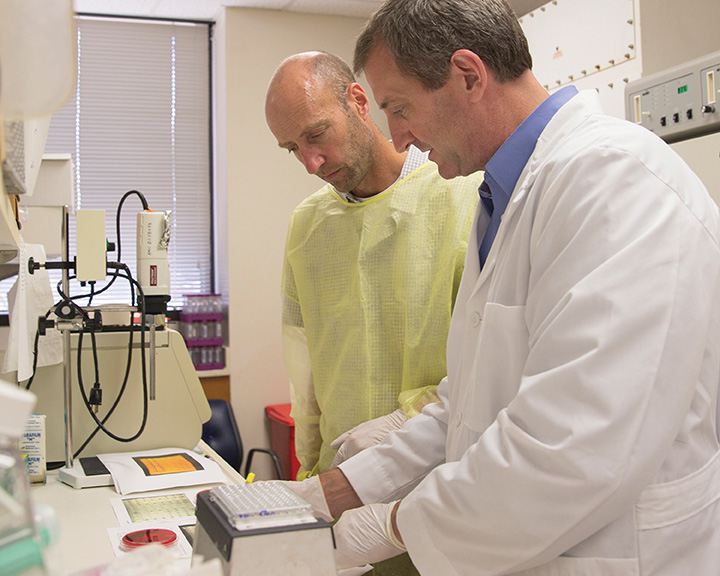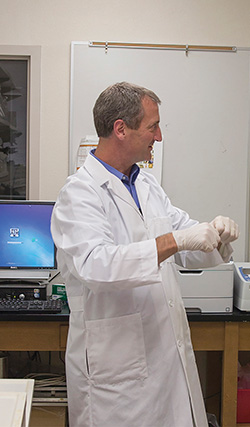Dr. H. Morgan Scott: Viewing Epidemiology through a Different Lens
Dr. H. Morgan Scott has ridden his bicycle around the world, but he keeps coming back to College Station. Scott, an epidemiologist and infectious disease expert who taught at Texas A&M University from 2001–2009, has returned to the Texas A&M College of Veterinary Medicine & Biomedical Science (CVM) after a stretch as the E.J. Frick Endowed Professor of Veterinary Medicine at Kansas State University. He will lead the development of the Microbial Ecology and Molecular Epidemiology (ME2) research laboratory at the CVM as a tenured epidemiology professor in the Department of Veterinary Pathobiology.
 Dr. Scott didn’t originally plan to be an epidemiologist, however. The Canada native first encountered epidemiology while pursuing a DVM from University of Saskatchewan, when an eccentric professor who incorporated props into each lecture piqued Scott’s interest. Once Scott graduated in 1988 and started working as a practitioner at larger cattle farms, he realized that his veterinary training wasn’t extensive enough to tackle the issues at hand. “These farms had herd health questions that were simple on the surface, but very difficult to answer,” Scott said.
Dr. Scott didn’t originally plan to be an epidemiologist, however. The Canada native first encountered epidemiology while pursuing a DVM from University of Saskatchewan, when an eccentric professor who incorporated props into each lecture piqued Scott’s interest. Once Scott graduated in 1988 and started working as a practitioner at larger cattle farms, he realized that his veterinary training wasn’t extensive enough to tackle the issues at hand. “These farms had herd health questions that were simple on the surface, but very difficult to answer,” Scott said.
Heading into the Ph.D. program at the University of Guelph in the Canadian province of Ontario, he fully intended to get back into veterinary practice one day. Instead, he turned to epidemiology to explore the best methods of reducing disease burden in animals.
Today Scott is establishing ME2 at the CVM, but at the time, Scott shared that he never envisioned having a lab. “I saw the world as my lab-which is clichéd and naïve,” Scott said. He soon realized that in order to conduct experiments, he needed a controlled area for his research-which he couldn’t outsource. He learned to work with colleagues in different fields to meet his research needs and gain access to other useful and pertinent data.
As it turns out, cross-disciplinary collaboration has become a hallmark of Scott’s career. He began postdoctoral studies in public health and research in risk analysis at the University of Alberta in 1999. While in Alberta, he shared an office with a moral philosopher, a sociologist, a toxicologist, an occupational hygienist, a civil engineer, and an ethicist. “I developed an enormous appreciation for the other aspects of human health, of how humans behave with respect to everything we do,” said Scott. “This also applies to farming and agriculture. People like to say the farming business is entirely economic, but it’s not.”
Now he continues to work with researchers in other disciplines and understands one person can’t be an expert in everything. “Projects end up being more exciting this way. It’s about evaluating what people bring to the table and recognizing you can appreciate each other, which makes science fun,” Scott said. “You read a crazy idea and say, ‘Hey, maybe we can make that work here.'”
 Members of ME2 study zoonotic disease control to improve food safety and public health. Scott ultimately hopes to reduce resistance to antibiotics among zoonotic bacteria, which can be transferred from animals to humans. He examines and observes how bacteria compete against each other in areas with finite resources, like within an animal’s digestive system. Scott and his team use microbiological and molecular methods to measure whether certain bacteria are resistant to antibiotics. These researchers also use genetic tools including recent moves into whole genome sequencing to observe how one strain of a bacterium is particularly successful at outcompeting others.
Members of ME2 study zoonotic disease control to improve food safety and public health. Scott ultimately hopes to reduce resistance to antibiotics among zoonotic bacteria, which can be transferred from animals to humans. He examines and observes how bacteria compete against each other in areas with finite resources, like within an animal’s digestive system. Scott and his team use microbiological and molecular methods to measure whether certain bacteria are resistant to antibiotics. These researchers also use genetic tools including recent moves into whole genome sequencing to observe how one strain of a bacterium is particularly successful at outcompeting others.
Scott’s lab is being stationed in the new Veterinary Research Building annex, and he has filled the 1400-square-foot space with top-of-the-line equipment. His research will be conducted entirely out of ME2 with the assistance of a six-person (and growing) team, which will include CVM graduate students. ME2 receives some of its start-up funding from the Chancellor’s Research Initiative, among others.
“Dr. Scott’s efforts in the laboratory will translate to an innovative and dynamic learning opportunity for our graduate and veterinary students,” said Dr. Linda Logan, former head of the Department of Veterinary Pathobiology. “Learning from his experiences will prepare our graduate students with practical and applied knowledge and skill sets for future roles in government, industry, and academia.”
An integral part of Scott’s work is rooted in communication with the public. During his more than 20-year career, Scott has seen food safety information grow from nonexistent to routine and systematic. He briefly worked as an epidemiologist for the Food Safety Division of the Government of Alberta in 2000, where he learned to use foodborne pathogens as a way to measure whether an intervention was effective. There he helped establish and monitor food safety outcomes; this research involved collecting data on foodborne disease pathogens in particular areas. While there have been some improvements in surveillance on the human side, scientists still don’t know the extent of antibiotic use on the animal side. “Molecular work lets you trace an organism back to its origin, see how it’s changed over time, observe its lineage, and note its acquisition of resistance,” Scott said. “In terms of how we use antibiotics [in animals], we still don’t have any broad and useful national data at this point.”
Scott says that how to use these data to effect policy change isn’t a question for scientists, but rather a discussion for the public. Society has to decide if it wants these data to be used to make informed decisions about the continued use of antibiotics in its food production systems. At that point, discourse leaves the scientific arena and enters into political debate. For example, in an October 2014 interview for PBS Frontline, Scott discussed how his team noticed that cephalosporin, an antibiotic, was losing its effectiveness among Gram-negative bacteria, which can have adverse effects on human health. When researchers tried using an alternative antibiotic, tetracycline, to reduce resistance to cephalosporin, the resistance to cephalosporin actually increased. “If someone wants me to detail the best way to use antibiotics, I can’t actually give them that answer at the moment,” Scott said. “The timeline of resistance development spans decades, and decisions on how to use antibiotics need to project at least that far into the future.”
With his interdisciplinary approach to research, Scott says being at a large, multiservice university like Texas A&M is very appealing. On such a large campus, there are ample opportunities to collaborate with people working nearby. He recalls that even when he first started at Texas A&M in 2001, he received nothing but support for his research. “I always have lots of encouragement to pursue my interests,” Scott said.
Scott’s areas of expertise complement the CVM’s One Health Initiative, which explores the connections between human, animal, and environmental health. He notes that measures taken in animal agriculture affect human health and vice versa. “My work sits at the intersection of agriculture, human health, and human activity in general,” Scott said.
In addition to leading the ME2 lab, Scott will teach graduate courses on risk analysis as well as disease detection and surveillance. He is the immediate past president of the Association for Veterinary Epidemiology and Preventive Medicine and an advisor to the World Health Organization Advisory Group on Integrated Surveillance for Antimicrobial Resistance. His wife, Dr. Cheryl Herman, also returns to the CVM as a clinical associate professor of anatomy. They continue to cycle when they can find the time.


